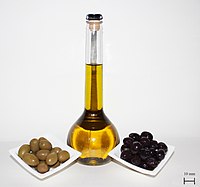
Photo from wikipedia
AbstractThis work is aimed to evaluate the applicability of solid portion of olive mill wastewater (OMW) for its utility as a renewable biofuel . A solar still unit was used… Click to show full abstract
AbstractThis work is aimed to evaluate the applicability of solid portion of olive mill wastewater (OMW) for its utility as a renewable biofuel . A solar still unit was used to separate the solid residual from the liquid part of OMW. Three triplicate samples of solid residue were collected and tested for their calorific value, proximate analysis, and elemental analysis. The average calorific values obtained based on oxygen bomb calorimeter were 24 ± 0.65 kJ/g which agreed well with that obtained from elemental analysis (23 ± 1.3 kJ/g). This value is higher than that of refuse-derived fuel and lower than that of oil or natural gas but close to that of coal. Results of proximate analysis indicate a high combustible portion (83%) of OMW-Biofuel. The total amount of energy that can be produced from OMW-Biofuel in Jordan, expressed in terms of oil equivalent, accounts for <1.0% of the total imported oil by Jordan in 2014 and, if utilized, would result in annual savings of about US$ 17 million. These results suggest that the OMW-Biofuel can be applicable as a potential fuel.
Journal Title: Energy, Ecology and Environment
Year Published: 2017
Link to full text (if available)
Share on Social Media: Sign Up to like & get
recommendations!